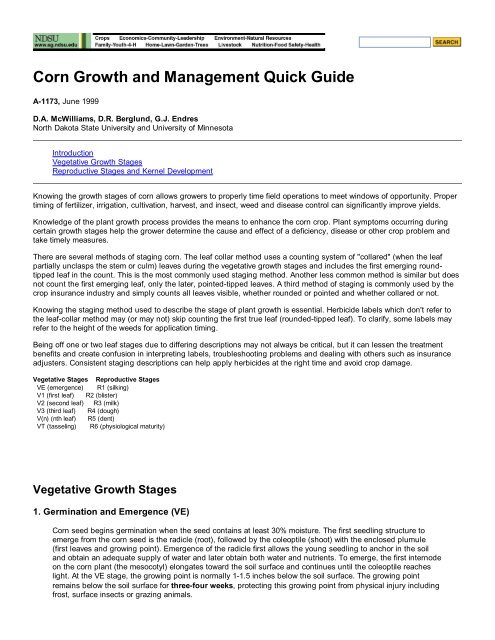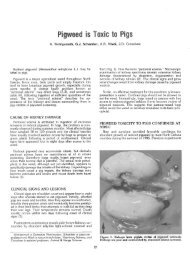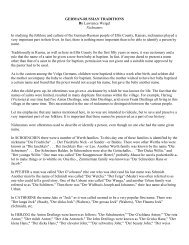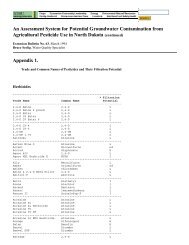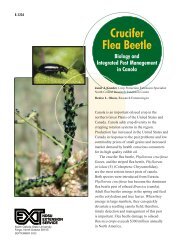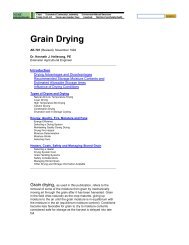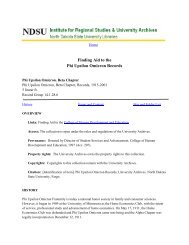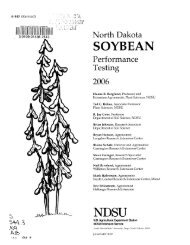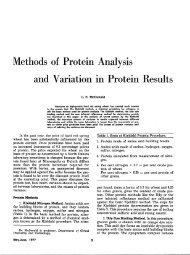Corn Growth and Management ...
Corn Growth and Management ...
Corn Growth and Management ...
You also want an ePaper? Increase the reach of your titles
YUMPU automatically turns print PDFs into web optimized ePapers that Google loves.
A-1173, June 1999<br />
D.A. McWilliams, D.R. Berglund, G.J. Endres<br />
North Dakota State University <strong>and</strong> University of Minnesota<br />
Introduction<br />
Vegetative <strong>Growth</strong> Stages<br />
Reproductive Stages <strong>and</strong> Kernel Development<br />
Knowing the growth stages of corn allows growers to properly time field operations to meet windows of opportunity. Proper<br />
timing of fertilizer, irrigation, cultivation, harvest, <strong>and</strong> insect, weed <strong>and</strong> disease control can significantly improve yields.<br />
Knowledge of the plant growth process provides the means to enhance the corn crop. Plant symptoms occurring during<br />
certain growth stages help the grower determine the cause <strong>and</strong> effect of a deficiency, disease or other crop problem <strong>and</strong><br />
take timely measures.<br />
There are several methods of staging corn. The leaf collar method uses a counting system of "collared" (when the leaf<br />
partially unclasps the stem or culm) leaves during the vegetative growth stages <strong>and</strong> includes the first emerging roundtipped<br />
leaf in the count. This is the most commonly used staging method. Another less common method is similar but does<br />
not count the first emerging leaf, only the later, pointed-tipped leaves. A third method of staging is commonly used by the<br />
crop insurance industry <strong>and</strong> simply counts all leaves visible, whether rounded or pointed <strong>and</strong> whether collared or not.<br />
Knowing the staging method used to describe the stage of plant growth is essential. Herbicide labels which don't refer to<br />
the leaf-collar method may (or may not) skip counting the first true leaf (rounded-tipped leaf). To clarify, some labels may<br />
refer to the height of the weeds for application timing.<br />
Being off one or two leaf stages due to differing descriptions may not always be critical, but it can lessen the treatment<br />
benefits <strong>and</strong> create confusion in interpreting labels, troubleshooting problems <strong>and</strong> dealing with others such as insurance<br />
adjusters. Consistent staging descriptions can help apply herbicides at the right time <strong>and</strong> avoid crop damage.<br />
Vegetative Stages Reproductive Stages<br />
VE (emergence) R1 (silking)<br />
V1 (first leaf) R2 (blister)<br />
V2 (second leaf) R3 (milk)<br />
V3 (third leaf) R4 (dough)<br />
V(n) (nth leaf) R5 (dent)<br />
VT (tasseling) R6 (physiological maturity)<br />
Vegetative <strong>Growth</strong> Stages<br />
1. Germination <strong>and</strong> Emergence (VE)<br />
<strong>Corn</strong> seed begins germination when the seed contains at least 30% moisture. The first seedling structure to<br />
emerge from the corn seed is the radicle (root), followed by the coleoptile (shoot) with the enclosed plumule<br />
(first leaves <strong>and</strong> growing point). Emergence of the radicle first allows the young seedling to anchor in the soil<br />
<strong>and</strong> obtain an adequate supply of water <strong>and</strong> later obtain both water <strong>and</strong> nutrients. To emerge, the first internode<br />
on the corn plant (the mesocotyl) elongates toward the soil surface <strong>and</strong> continues until the coleoptile reaches<br />
light. At the VE stage, the growing point is normally 1-1.5 inches below the soil surface. The growing point<br />
remains below the soil surface for three-four weeks, protecting this growing point from physical injury including<br />
frost, surface insects or grazing animals.
Figure 1. Germination <strong>and</strong> emergence 0, 2, 4, 5, <strong>and</strong> 6 days after planting. (29KB color<br />
photo)<br />
Effect of Planting Dates on <strong>Corn</strong> Grain Yield<br />
-------------------------------<br />
Yield<br />
Planting Date Potential (%)<br />
-------------------------------<br />
May 1 100<br />
May 5 97 Good<br />
May 10 94 Planting<br />
May 15 91 Range<br />
-------------------------------<br />
May 20 88<br />
May 25 86<br />
May 30 83<br />
-------------------------------<br />
2. V1-V2<br />
These growth stages occur about one week after the plant emerges. Since the root system is relatively small<br />
<strong>and</strong> the soil is cool, higher concentrations of fertilizer nutrients stimulate early plant growth. However, the<br />
amounts of nutrients required are relatively small <strong>and</strong> fertilizer placed in a b<strong>and</strong> where the primary roots will<br />
contact it will allow effect uptake at this stage. The roots of the corn plant in the first whorl are elongating.<br />
Figure 2. V2 plant. (29KB color photo)<br />
3. V3-V5<br />
Two weeks after the plant emerges, the V3 stage begins. Cultivation too near the plant after this time will destroy<br />
some of the permanent root system. A frost (light freeze) or hail may destroy the exposed leaves but will not<br />
damage the growing point below the soil surface, so damage to the plant above the soil surface at this time<br />
usually results in very little reduction in yield. <strong>Growth</strong> of the seedling root system has essentially ceased. Root<br />
hairs are present on nodal roots. The roots of the second whorl are elongating. The nodal roots now form the<br />
major part of the root system. Leaf <strong>and</strong> ear shoots are being initiated <strong>and</strong> this initiation will be complete by V5<br />
(potential ear shoot number is determined). Also by V5, a microscopically small tassel is initiated at the<br />
growing point. Above ground plant height is about 8 inches when the tassel is initiated, but the growing point is<br />
still at or just under the soil surface. However, soil temperature can affect the growing point. Cold soil<br />
temperatures can:<br />
a.<br />
b.<br />
c.<br />
d.<br />
increase the time between leaf stages<br />
increase the total number of leaves formed<br />
delay tassel formation<br />
reduce nutrient availability<br />
Weeds are now also competing for water, nutrients <strong>and</strong> light. Chemicals, cultivation <strong>and</strong> higher plant<br />
populations or crop rotation used in crop planning can reduce weed pressure <strong>and</strong> limit the competition to the<br />
corn crop.<br />
Figure 3. V3 plant. (27KB color photo)<br />
4. V6-V7
Three weeks after the plant emerges, the plant enters the V6 stage. The root system is well<br />
distributed in the soil <strong>and</strong> extends about 18 inches in depth <strong>and</strong> 24 inches in radius. The third root<br />
whorl is elongating. The plant is now absorbing greater amounts of nutrients, so fertilizer<br />
applications in amounts adequate to replace soil needs are beneficial at this time. The growing<br />
point is above the soil surface <strong>and</strong> rapid stem elongation begins. Some tillers (suckers) may have<br />
initiated. Sucker development varies with hybrid, plant density, fertility <strong>and</strong> other environmental<br />
conditions. Row-applied fertilizer is less critical now as nodal roots have proliferated throughout the<br />
soil. Nitrogen can be side-dressed up to V8 if placed in moist soil <strong>and</strong> excess root pruning <strong>and</strong><br />
injury of above-ground plant parts are avoided.<br />
Figure 4. V6 plant. (38KB color photo)<br />
Figure 5. Magnified tassel of V7 plant. (24KB color photo)<br />
5. V8-V9<br />
Four weeks after the plant emerges, it enters V8. Macronutrient <strong>and</strong> micronutrient deficiencies can appear<br />
at this time. Foliar applications may correct some soil deficiencies, especially if applied before the symptoms.<br />
Nutrient deficiencies at this stage seriously restrict leaf growth. The fourth whorl of nodal roots is elongating.<br />
Several ear shoots are present. A potential ear shoot will form at every above-ground node except the upper six<br />
to eight. Initially, each ear shoot develops faster than the one above, but growth of the lower ear shoots slows.<br />
Only the upper one or two ear shoots eventually form harvestable ears. Prolific hybrids tend to form more than<br />
one harvestable ear, especially at lower plant populations. Removal of all the unfurled leaves of the plant at this<br />
stage (by frost or hail) may result in 10-20% reduction in final grain yield. Flooding at this or any earlier stage<br />
when the growing point is below ground can kill the corn plants in a few days, especially if temperatures are<br />
high. Flooding at later stages, with the growing point above the soil surface, is not as detrimental.<br />
Figure 6. V9 plant. (31KB color photo)<br />
6. V10-V11<br />
Five weeks after the plant emerges, it enters V10. The corn plant begins a steady <strong>and</strong> rapid increase in both<br />
nutrient <strong>and</strong> dry matter accumulation. The time between appearance of new leaves is shortened with a new leaf<br />
now appearing every two to three days. Dem<strong>and</strong> for soil nutrients <strong>and</strong> water are relatively high in order to<br />
meet the needs of the increased growth rate. Moisture <strong>and</strong> nutrient deficiencies at this stage will markedly<br />
influence the growth <strong>and</strong> development of the ears. Fertilizer is needed near the roots, especially phosphorus<br />
<strong>and</strong> potassium, which do not move appreciable distances in most soils. Dry soils may also make needed<br />
nutrients less available.<br />
7. V12-V13<br />
Six weeks after the plant emerges, V12 begins. Moisture or nutrient deficiencies may seriously reduce the<br />
potential number of seeds as well as the ear size. These two components of yield have key development during<br />
the period from V10 to V17, length of time for the plant to develop through these stages affects harvestable
yield. Early maturity hybrids normally progress through these stages in less time <strong>and</strong> have smaller ears than<br />
later hybrids. Higher plant populations are needed for earlier hybrids to produce grain yield similar to normal<br />
maturity hybrids in the adapted region. Cultivation of plants at this time will destroy some of the plant roots.<br />
Brace roots are developing from the fifth node <strong>and</strong> the first above-ground node.<br />
Figure 7. Magnified top ear of V12 plant. (27KB color photo)<br />
Figure 8. V12 plant. (26KB color photo)<br />
8. V14-V15<br />
Seven weeks after the plant emerges, V14 begins. The corn plant at V15 is only 12 to 15 days (around one-five<br />
V stages) away from R1 (silking). This vegetative stage is the most critical period of seed yield determination.<br />
The number of ovules which develop silks, <strong>and</strong> thus the number of kernels, is being determined. Any nutrient<br />
or moisture deficiency or injury (such as hail or insects) may seriously reduce the number of kernels that<br />
develop. The tassel is near full size but not visible from the top of the leaf sheaths. Silks are just beginning to<br />
grow from the upper ears. Upper ear shoot development has surpassed that of lower ear shoots. A new leaf<br />
stage can occur every one to two days. Brace roots from the sixth leaf node are developing <strong>and</strong> the<br />
permanent roots have continued to elongate <strong>and</strong> proliferate, eventually reaching a depth of about 5 to 8 feet <strong>and</strong><br />
spreading several feet in all directions. In some hybrids, brace roots will also develop from the eighth <strong>and</strong> ninth<br />
leaf nodes or even higher. Some corn plants in North Dakota may only develop 16 leaves.<br />
Figure 9. V15 plant. (23KB color photo)<br />
9. V16-V17<br />
Eight weeks after the plant emerges, it is entering the late vegetative stages if the plant has not already<br />
developed its total number of plant leaves. During this time, plant stress can greatly affect yield. Moisture<br />
stress two weeks before or after silking can cause a large grain yield reduction. In general, this is true for<br />
other types of environmental stresses (hail, high temperature, nutrient deficiencies) during this time. The<br />
four-week period around silking is the most effective time for irrigation if water supply is short. Tips of upper ear<br />
shoots may be visible at the top of leaf sheaths by V17 in hybrids which develop more than 16 leaves. The tip of<br />
the tassel may also be visible by V17 in more prolific-leaf hybrids.<br />
10. V18 <strong>and</strong> other numbered vegetative stages which may follow.<br />
The vegetative plant is reaching full size in prolific-leaf hybrids. Silks from the basal ear ovules have been<br />
the first to elongate, followed by the silks from the ear tip ovules. Brace roots are now growing from aboveground<br />
nodes. These brace roots provide support to the plant <strong>and</strong> obtain water <strong>and</strong> nutrients from the upper soil<br />
layers during the reproductive plant stages. Ear development is continuing rapidly with the plant only one week<br />
away from viable silking at V18. Stress in these later vegetative stages will delay beginning silking more than<br />
beginning pollen shed (which might cause the corn to delay silking until pollen shed is partially or completely<br />
finished—causing the nick to be missed). Unfertilized ovules result in missing kernels on the ear, especially at<br />
the ear tip. Yield of prolific-eared hybrids (two or more ears per plant) is more stable under stress conditions,<br />
although non-prolific hybrids (strongly single-eared) which are currently available will often outyield prolific
hybrids under non-stress conditions.<br />
Figure 10. V18 plant. (23KB color photo)<br />
Yield Reduction in <strong>Corn</strong> due to Drought<br />
------------------------------------------------------<br />
Yield Reduction<br />
Age of the per Drought % Total<br />
<strong>Corn</strong> Plant Stage Day (%) Reduction<br />
------------------------------------------------------<br />
1-33 days* GE-V5 --- ---<br />
Next 22-32 days V6-V15 2.0 25<br />
Next 5-15 days V16-R2 6.0 50<br />
Next 20-30 days R3-R5 1.5 25<br />
Next 5-15 days** R6 --- ---<br />
------------------------------------------------------<br />
* Yield reduction depends on many variables including<br />
germination <strong>and</strong> upper soil profile moisture.<br />
** Overall drought period will affect yield reduction.<br />
A continuous drought may result in 100% reduction.<br />
11. VT (tasseling)<br />
Stage VT occurs two to three days before silking, when the last branch of the tassel is completely visible but<br />
silks have not yet emerged from the ear shoot. The plant has reached full height <strong>and</strong> the pollen shed<br />
begins. The time between VT <strong>and</strong> R1 can vary with different hybrids <strong>and</strong> due to environmental conditions.<br />
Pollen shed (pollen drop) normally occurs during the late morning or early evening. Hail damage is more serious<br />
at this time than for any other growth period. All leaves have already emerged <strong>and</strong> complete loss of a pollen<br />
source would result in no grain formation.<br />
Figure 11. VT plant. (21KB color photo)<br />
Critical Field <strong>Corn</strong> <strong>Growth</strong> Stages<br />
------------------------------------------------------------------<br />
<strong>Growth</strong> Days after<br />
Stage Emergence <strong>Growth</strong> Event Importance<br />
------------------------------------------------------------------<br />
V3 9-12 Seminal root system Seedling vigor seen,<br />
<strong>and</strong> ear shoots<br />
ears established<br />
initiated<br />
------------------------------------------------------------------<br />
V4 to 14-21 Ear shoot initiation Number of kernel<br />
V5 complete rows determined<br />
------------------------------------------------------------------<br />
V6 21-25 Nodal root system Plant's ability to<br />
established<br />
take up nutrients <strong>and</strong><br />
water is established<br />
------------------------------------------------------------------<br />
V12 to 42-49 Number of ovules Number of kernels per<br />
V14 determined row determined<br />
------------------------------------------------------------------<br />
R1 63-68 Pollen shed begins, Kernel fertilization,<br />
(silking)<br />
brace roots establish, support ear weight,<br />
near maximum root kernel fill<br />
mass<br />
------------------------------------------------------------------
[ More ] [ Reproductive Stages <strong>and</strong> Kernel Development ]<br />
A-1173, June 1999<br />
County Commissions, North Dakota State University <strong>and</strong> U.S. Department of Agriculture cooperating. North Dakota State University does not<br />
discriminate on the basis of race, color, national origin, religion, sex, gender identity, disability, age, status as a U.S. veteran, sexual orientation, marital<br />
status, or public assistance status. Direct inquiries to the Vice President for Equity, Diversity <strong>and</strong> Global Outreach, 205 Old Main, (701) 231-7708. This<br />
publication will be made available in alternative formats for people with disabilities upon request, 701 231-7881.<br />
Information for Prospective Students<br />
NDSU is an equal opportunity institution<br />
This information may be photocopied for noncommercial, educational purposes in its entirety with no changes.<br />
Requests to use any portion of the document should be sent to NDSU.permission@ndsu.edu.<br />
North Dakota State University Agriculture <strong>and</strong> University Extension<br />
Dept. 7070, Morrill 7, P.O. Box 6050, Fargo, ND 58108-6050


